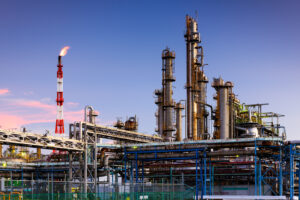Dangote’s New Refinery in Nigeria and Kenya’s Quest for Energy Independence


In a significant development this week, Aliko Dangote, a prominent Nigerian businessman, inaugurated Africa’s largest petroleum refinery. With a daily processing capacity of 65,000 barrels of petroleum, this privately owned refinery is set to revolutionise Nigeria’s fuel industry. The country, despite being an oil producer, has long struggled with fuel shortages and has heavily relied on imports due to inefficiencies in government-owned refineries. However, with the introduction of this state-of-the-art facility, Nigeria’s fuel landscape is poised for a positive transformation.
The new refinery is expected to alleviate the nation’s dependence on fuel imports, which currently account for over 80% of Nigeria’s refined petroleum products. The ripple effect of this development will reverberate across various sectors heavily reliant on petroleum, boosting local manufacturing and igniting economic growth. Transportation, industry, and agriculture are among the sectors that will experience a significant uplift as a result of increased fuel availability and improved supply chain dynamics.
It however poses a problem for the country in terms of carbon footprint impact and calls into question the country’s reliance on fossil fuels even though it contributes less than 1% of global emissions. It is estimated that the country has the capacity to harness over 60% of its energy from renewable sources by 2050. Presently, thermal sources account for 80% of Nigeria’s power generation, with the remainder coming from hydroelectric power. However, with concerted efforts and strategic investments, Nigeria can tap into its renewable energy potential and reduce its dependence on fossil fuels.
In sharp contrast, Kenya’s oil project has faced numerous setbacks due to the changing fuel landscape. It is estimated that Kenya possesses over four billion barrels of crude oil reserves in the Lokichar basin, but tapping into these reserves has proven challenging thus far. Furthermore, fuel prices have experienced a significant rise in recent months after the president removed a fuel subsidy at the beginning of his term. Additionally, there has been a harmonisation exercise that raised the VAT on fuel from 8% to 16%, impacting all sectors dependent on fuel. Regarding infrastructure, the Kenya Pipeline Company (KPC) recently acquired the defunct Kenya Petroleum Refinery Limited (KPRL). KPRL boasts 45 tanks with a total storage capacity of 484 million litres, out of which 254 million litres are reserved for refined products, while the remaining 233 million litres are allocated for crude oil. Furthermore, in conjunction with the newly inaugurated Kipevu Oil Terminal at the Mombasa port, KPC plans to expand its storage capacity. This development aims to enable Kenya to compete with Tanzania, which has traditionally held dominance as the primary petroleum hub in the region.
However, Kenya’s energy mix presents a complete contrast to that of Nigeria. In Kenya, a remarkable 81% of electricity generation is derived from green energy sources, such as hydroelectric power, wind energy, and geothermal power. The remaining portion of the energy mix is composed of thermal sources, which include fossil fuels like coal and natural gas.
This emphasis on green energy has positioned Kenya as a leader in renewable energy adoption within Africa. The country has made significant investments in harnessing its abundant renewable resources, including its vast geothermal potential in the Rift Valley region. By prioritising green energy sources, Kenya has been able to reduce its reliance on traditional thermal power generation, which contributes to carbon emissions and environmental degradation.
Both countries still have a significant journey ahead of them to achieve a sustainable energy mix capable of meeting their respective energy demands, all while simultaneously addressing environmental concerns.

